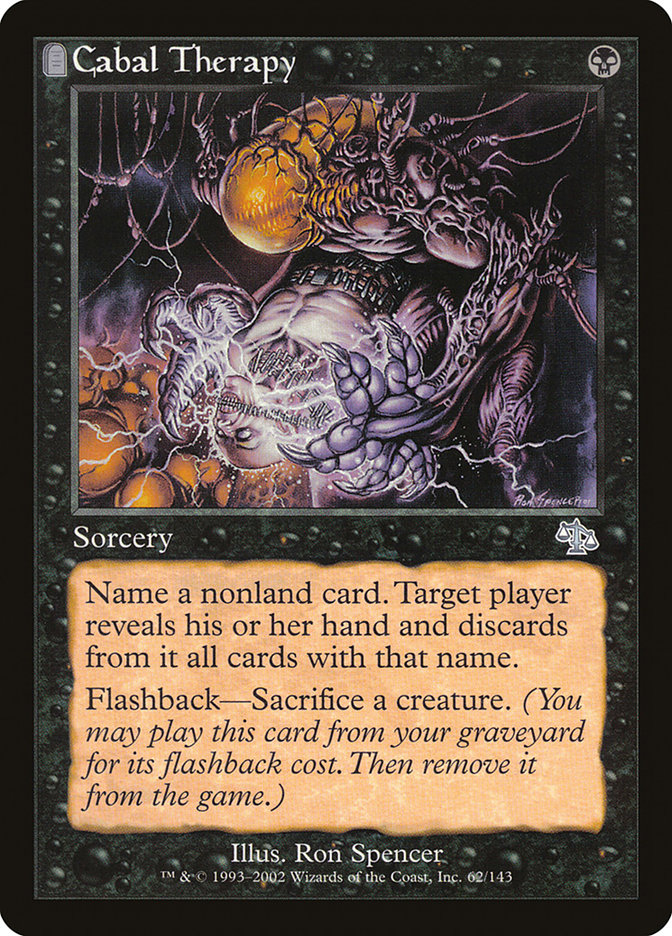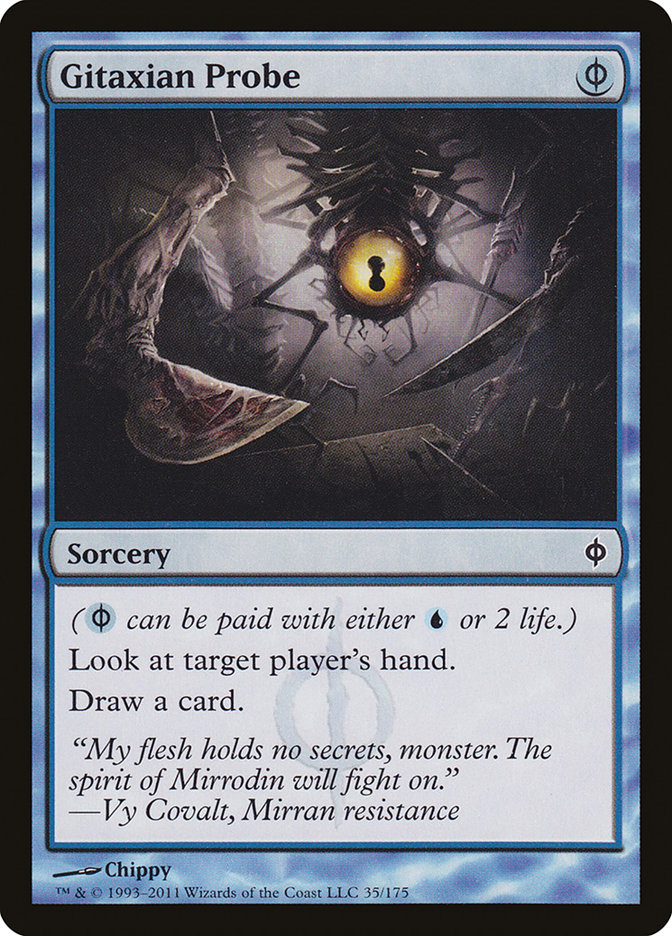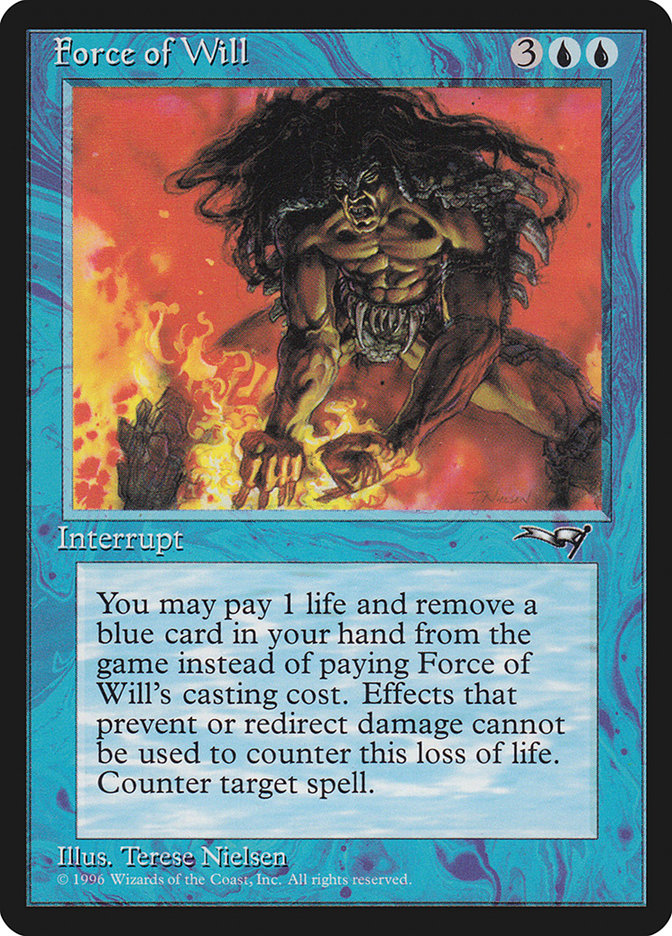Once upon a few years ago, I was sitting at a nondescript table in a nondescript tournament hall playing a favorite game of Magic players: making lists of
Magic cards. This time, the starting point was “most skill-intensive cards ever.”
Unsurprisingly, most of the cards had to do with card selection and tutoring. The consensus number one was Doomsday – as AJ Sacher put it, “you tutor five
times and stack your deck on the fly, how hard can it be?” – with the caveat that it was “probably too hard for a normal human to play to maximum
potential.” Gifts Ungiven made the top five. Brainstorm and Sensei’s Divining Top were easy additions. But one card made it that didn’t tutor, didn’t
rearrange your deck, and really had very little to do with your own cards.
That card, of course, is Cabal Therapy, the subject of this week’s Single Card Primer.
In a small format – Block, say – Cabal Therapy isn’t that difficult to play with. There are cards whose power level is head and shoulders above others’,
they are deckbuilding staples, and you can generally name those and be successful. In a format like Standard, it can get a little harder. But zoom all the
way out.
Legacy is a format where tens of thousands of unique cards are legal. People aren’t going to play all of them, or even most of them, but they are going to
find some weird ones. The range of playable decks is extraordinarily wide, the fundamental turn of the format is very low, and so you don’t always know
exactly what your opponent is up to by the time you need to effectively disrupt them. If you can get it right, though, you’ll have a great follow-up
disruption spell in the next turn or two to further derail their gameplan. That’s Cabal Therapy in Legacy: difficult, rewarding careful research and strong
imagination, and very powerful when applied correctly.
On a super basic level, Cabal Therapy is a one-mana black discard spell, which immediately puts it in competition with Thoughtseize, Duress, and
Inquisition of Kozilek as far as playability goes. Obvious downsides in that comparison: you don’t get to see their hand first. Obvious upsides: you get to
hit all of their copies, you get to flash it back, and you get to sacrifice one of your creatures for free. That last one may look like a weird upside, but
Sam Black has been getting paid for years for figuring out how to turn killing his own stuff into upside.
Let’s start with the most basic comparisons: When is Cabal Therapy going to be better than Thoughtseize? Both can take the exact same class of card. The
tradeoff is basically would you rather have:
[Option 1]
– Always getting to take their best card
– Getting to make your decision about their best card with full information of their hand
– Losing two life
Or
[Option 2]
– Not always getting to take a card
– Getting to take multiple copies of the card you want to take, if present
– Making your decision before seeing their hand
– Not losing life
– Getting to do this a second time in exchange for zero mana and sacrificing a creature.
As you can see, the two cards look very similar on their faces but go in very different strategies. You’re going to end up doing rather poorly if you view
Cabal Therapy as a versatile disruption card in a midrange strategy that wants to shift gears a lot. Similarly, you’ll end up leaving value on the table if
you play Thoughtseize in your Dredge deck. More on that side of things soon.
There are basically two great ways to play with Cabal Therapy: proactively and reactively. For those of you with a lot of context into Legacy, my proactive
example is any deck that Sam Black has ever built (or Dredge, really) and my reactive example is Storm. Let’s start with the reactive example.
One of the great ways to play with Cabal Therapy is when you know what you want to target in every single matchup. If I sit down with my Cabal Therapy deck
and I know what my opponent is playing, I know what I want to name. I know what beats me, and my desire to take away that card (or class of cards) is
strong enough that I’m okay with the occasional swing and a miss.
The contemporary example of this style of Cabal Therapy deck is Storm, a deck that commonly plays zero ways in its entire deck to Flashback Cabal Therapy
(okay, maybe Past in Flames, but still). Why play Cabal Therapy in that context? Well, for starters:
A common opener for Storm is “land, Probe you, Therapy you.” In a way, it’s a build-your-own-Thoughtseize. You may wonder, then, why Storm decks don’t just
cut out the middleman and play actual Thoughtseize, right? I mean, if you’re going to go to the trouble of playing Peek and a one-shot Cabal Therapy, why
not replace it with Thoughtseize?
The thing is, you don’t want too much life loss in your deck that wants to cast Ad Nauseam after hanging out for several turns without casting removal or
countermagic, just getting beat up. Gitaxian Probe is so unbelievably perfect for a Storm deck that you always want four (it has countless synergies
internal to the deck), so that’s never getting cut. At the point where you’re looking at their hand for zero mana on any turn (but ideally the turn you’re
going to go off, because +1 storm count), Cabal Therapy is less painful than Thoughtseize while also taking all of, say, their Force of Wills. Imagine that
you’re playing Storm and you Probe your opponent and see the following:
If you’re casting a one-mana discard spell into that hand, you want it to be Cabal Therapy. You get both of their Force of Wills offline no matter how they
play it, and you probably get to kill them that turn. If your discard spell is Duress or Thoughtseize, you can’t win.
If you go into your match knowing that you want to take out their Force of Wills and maybe their Flusterstorms, you’ll be most of the way there. The hard
part of the card (what to name) is a settled issue, and you can focus on timing it correctly. Against Jund, you want to name their Hymn to Tourachs.
Against a white creature deck, their Thalias. The list goes on, but you can fill it out pretty easily. As Richard Feldman once said:
“U
sing Therapy to beat hate cards is straightforward: think of the card you fear, picture it in your mind, and then say its name out loud. Do this as
Cabal Therapy is resolving.
“
He’s right. And if you want to make an exhaustive list of decks and hate cards for each matchup before the tournament and study it between rounds, you’ll
be that much more prepared. At the core of effectively using Cabal Therapy is a nuanced understanding of what people are likely to have in their deck. If
you’re playing Storm and you don’t know what Miracles is likely to sideboard against you, your Cabal Therapies will be far worse in games 2 and 3. Even
when your list of potential targets for Therapy is smaller than “their entire deck,” you have to know what’s important.
By contrast, a proactive Cabal Therapy deck is typically more of a value-based midrange setup that uses every part of Cabal Therapy as effectively as
possible. A neat example of this comes from a game of Sam Black’s Zombie deck a few years back. Per his article:
“In game 3 I had the awesome start of turn 1 Faithless Looting discarding Bloodghast, turn 2 Cabal Therapy naming Swords to Plowshares and hitting, then playing a fetchland to flash my Cabal Therapy back with my Bloodghast, hitting another card, fetching to return Bloodghast, using the mana to Cabal Therapy him again, and then sacrificing the Bloodghast to flash it back and pull a fourth card from his hand.“
One Bloodghast, a fetchland, and two Cabal Therapies sniping the best four cards in an opponent’s hand sounds like a lot of value. The goals of Cabal
Therapy in a deck geared specifically toward flashing it back effectively are a lot broader and often more value-oriented. In a deck with Blood Artist,
Gravecrawler, Bloodghast, and Lingering Souls, Cabal Therapy flashes back for free a lot of the time, which lets you play a double Thoughtseize for no life
and one mana. Sure, Sam Black’s Zombie deck could play Thoughtseize and have a nominal amount of disruption, but Cabal Therapy leverages many more angles
of value creation and has more upside.
The best Cabal Therapy deck I’ve ever seen is Dredge. That deck uses literally every part of Cabal Therapy. To wit:
– On the front end, it can be used on yourself to discard a card with Dredge, kickstarting your engine.
– On the front end, it can be used to clear the way for your permanent discard outlet against a tempo deck like Temur Delver.
– Its existence in your graveyard builds threshold for Cephalid Coliseum.
– It is a zero-mana sacrifice outlet for triggering Bridge from Below.
– It lets you kill Narcomoebas so that you can Golgari Thug them back on top of your deck.
– It adds value to already-dying Ichorids, using them for sacrificial fodder.
– The back end clears the way for Dread Return.
– The back end can knock out multiple copies of Golgari Grave-Troll from your hand, setting up a huge Cephalid Coliseum activation or Breakthrough.
Like I said, all of that from just one card. Oh, and I guess it’s pretty good against hate cards, too.
If you want a checklist of things that your deck can do to get more value from Cabal Therapy, looking at how Dredge is built is a great starting point. Not
every value-oriented deck with Cabal Therapy needs to hit all of the high points, but more is better.
A sweet way to hybridize the proactive and reactive types of Cabal Therapy deck is through the midrange-combo archetype:
Creatures (19)
- 1 Mogg Fanatic
- 4 Birds of Paradise
- 1 Carrion Feeder
- 1 Xantid Swarm
- 1 Tinder Wall
- 1 Wall of Roots
- 1 Academy Rector
- 1 Starved Rusalka
- 1 Wild Cantor
- 2 Protean Hulk
- 1 Body Double
- 1 Reveillark
- 1 Progenitus
- 1 Viscera Seer
- 1 Fauna Shaman
Lands (21)
Spells (20)
- 3 Pattern of Rebirth
- 2 Sylvan Library
- 4 Natural Order
- 4 Cabal Therapy
- 4 Green Sun's Zenith
- 3 Gitaxian Probe
Sideboard

Here, Cabal Therapy targets various pieces of disruption that break up the Protean Hulk combo while also serving as a free sacrifice outlet for Protean
Hulk and Academy Rector and Pattern of Rebirth combo-kills. When the combo isn’t ready to fire, a spare green fetchland can find one of two Dryad Arbors to
Flashback a disruptive Cabal Therapy.
This style of deck is a delight to play, but the major downside to the archetype is that it’s fairly spread out. A lack of consistency between games is a
great way to drop matches to brutally efficient Delver and combo decks. For a few more looks into what a Cabal Therapy-powered midrange deck can do, check
out some of the decks from my streak of Legacy brewing:
Creatures (4)
Planeswalkers (8)
Lands (24)
Spells (24)

Creatures (16)
- 1 Kiki-Jiki, Mirror Breaker
- 4 Veteran Explorer
- 4 Hunted Phantasm
- 1 Pestermite
- 2 Massacre Wurm
- 4 Deathrite Shaman
Lands (22)
Spells (22)
- 4 Brainstorm
- 4 Cabal Therapy
- 4 Defense of the Heart
- 2 Thoughtseize
- 4 Gitaxian Probe
- 4 Commune with the Gods
Sideboard

Both of these decks shared another deckbuilding element: Veteran Explorer. Having creatures that like to die is a huge boon for Cabal Therapy decks. If
you’re on all Tarmogoyfs and Dark Confidants and such, your Flashback really “costs” something. When you’re sacrificing a Veteran Explorer and grabbing two
lands to accelerate your gameplan, you might not even care if you hit your called shot.
Sam Black pushed this principle to the limit, maxing out on Bloodghasts and Gravecrawlers and Lingering Souls in his Zombies deck from a few years ago:
Creatures (18)
Lands (20)
Spells (22)
- 3 Goblin Bombardment
- 4 Cabal Therapy
- 4 Thoughtseize
- 2 Bitterblossom
- 4 Faithless Looting
- 4 Lingering Souls
- 1 Tragic Slip
Sideboard

This principle helps to explain why Cabal Therapy would be awful in a deck like Sultai Delver. I mean, how do you want this to go — you cast it, try to
hit a removal spell, see that they have their other removal spell in hand, and then which of your two large creatures are you going to sacrifice to make
them discard their removal spell? It’s embarrassing. Far better to play Thoughtseize in that spot – you want to have perfect information before deciding
what’s important, precisely because what’s important can and does change from turn to turn.
So what can you play to blunt the impact of Cabal Therapy? As always, it depends on what your gameplan is. In terms of the reactive Cabal Therapy decks
(think Storm), you can diversify your sideboard to reduce the odds of them hitting your important sideboard card. If you have four Flusterstorms, you’ll
always draw Flusterstorm. If your opponent names Flusterstorm with Cabal Therapy, though, you’re out your card. If you play two Flusterstorms, a Snapcaster
Mage, and a Vendilion Clique, though, you’ll be able to present hands that are more robust to Cabal Therapy while maintaining a density of anti-combo
cards. You give up some reactive speed with that plan, but life is full of tradeoffs.
This strategy was outlined by Richard Feldman in another article, one that I can’t seem to find. His core point was that the best way to attack a Dredge
deck, provided that you have four spots to do so, is with four differently-named cards so as to get past as many anti-hate measures as possible. Rather
than 4 Leyline of the Void, for instance, playing a Relic of Progenitus, a Tormod’s Crypt, a Yixlid Jailer, and a Leyline of the Void. Sure, you won’t get
nearly as many turn-0 kills, but you also have a ton more game against – surprise, surprise – Cabal Therapy. In situations where you don’t lose much by
diversifying, consider that there is a real advantage to be gained by doing so.
On a more operational level, when playing against Cabal Therapy, do not ask what they are naming if you want to respond. Naming a card with Cabal
Therapy is the first thing you do when Cabal Therapy is resolving. If you ask, “What are you naming with Cabal Therapy?” and they say “Brainstorm,” you
can’t Brainstorm in response.
The mind games while Cabal Therapy is on the stack are bountiful enough, though. If you have a Brainstorm, you can cast it before Cabal Therapy to hide
your best card. That’s the basic version. Most people will assume you did that and name the best card they think you’ll have left. This won’t always work,
though — a Storm player may just name Force of Will and kill you if you don’t have it.
If you freeze for a very small amount of time and then casually ask what they’re going to name, you may induce a value-oriented Cabal Therapy player to
name Brainstorm. Make sure you can actually sell this one, though. Also, I would recommend not having Brainstorm in your hand for this particular magic
trick.
If you’re bad at acting, try to react the same way each time you get Therapied. Your opponent is going to watch you carefully, and differences in behavior
are easier to figure out than you think.
If you really hate playing against Cabal Therapy, play Dredge — you’re very good against it, and you get to play it against other people constantly!
If you really hate playing with Cabal Therapy, I recommend playing with some of the 15,000 cards in Magic that aren’t Cabal Therapy.
If you really love playing with Cabal Therapy, let me know if there’s anything else you’d like to know about the card, building decks with it, or playing
with it.




